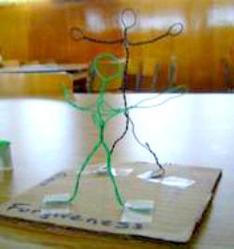WORMY NOTE:
This thread is a complete set of workshop lessons. During our 2013 renovation of this forum, reviewers recommended that this set be kept together, rather than separated into our Workshop threads, because the lessons strongly complement each other.
Lost & Found: The Prodigal Son
Lesson Set
Overview of all workshops in this Rotation:
--for 4th-6th grade:
- Art - Create wire sculptures of father & son posed at the moment of forgiveness. Examine emotions in the story.
- Cooking – make a fruit salad saving the rinds, etc. as pig slop. Discuss forgiveness.
- Games - Play a game of Bible bowling that helps students learn story details.
--for 1st- 3rd grade:
- Drama - Enact the story while learning story details.
- Photography - Create scenes from the story and photograph them. Discuss emotions.
- Video - Watch an animated video "The Prodigal Son" (Nest Series). Learn critical viewing skills. Discuss whom the characters represent.
Note: These workshops were written for 1st through 6th graders though not all grades visit all workshops due to our schedule and particular activities in certain workshops.
Scripture References: Luke 15:11-32
Key Bible Verse: “But we had to celebrate and be glad, because this brother of yours was dead and is alive again; he was lost and is found. Luke 15:32 (NIV)
Rotation Objectives--at the end of the Rotation, kids should be able to:
- (Older students) Locate the story in the Bible; (Younger students) Name that the story is found in the New Testament in the Gospels.
- Re-tell in his/her own words the story of the Prodigal Son.
- Define a parable as a story told by Jesus to teach his listeners something.
- Discover that God’s forgiveness is always available for the one who repents and asks for forgiveness. There is cause for celebration when we confess our sin & return to God.
- Examine the emotions and feelings of the characters; relate those feelings to their own lives.
- Question whom the characters represent in the story – does the father represent God, the one who is always seeking us, waiting patiently for us to come to our senses and return to him.
Main Points of the Story:
- A man had two sons; the younger son wanted his inheritance, which the father gave him.
- This son left home, went to a distant country and spent all his money foolishly.
- There was a famine where he was and since he was hungry, he took a job feeding pigs.
- This son is miserable working with pigs. He realizes how foolish he has been; He decides to go back home and ask his father for forgiveness.
- The “prodigal” son goes home.
- His father sees him coming, runs out & welcomes him, even ordering a feast in his honor.
- Meanwhile the older son comes in from the fields & hears a party. He asks the servants what’s going on. He is angry & refuses to join the celebration.
- The father explains to his older son why they must celebrate.
Story Background:
Jesus often taught using parables. Parables are stories that use examples from everyday life. They are stories told by Jesus to teach his listeners something. The intent is for ordinary people to understand God. This isn’t always easy. Don’t forget that in the Bible we see instances of the disciples not understanding Jesus’ parables. We can take this to mean that it’s ok for us to ask questions, and re-read or retell the story in order to find it’s deeper meaning. We can encourage this same activity with our kids.
In our story, Jesus tells the parable of a once wayward son reunited with his father and family after having squandered all his possessions. Like so many impatient people today, the younger son wanted to be free of parental restraints and have his father’s inheritance to spend as he chose. After losing it all, he comes to his senses, and realizes how good his ‘former’ life was. He resolves to go home and confess his unworthiness to be called his father’s son.
His father welcomes him home with compassion and love, and wants to celebrate, for “his son who was dead, is alive again; he was lost and has now been found” (paraphrase of Luke 15:24). Through this parable, Jesus illustrates the overwhelming love encompassing someone who returns to God after having repented of his foolish ways.
This story is one of the most well known of Jesus’ parables and is called “The Prodigal Son.” The word “prodigal” means reckless or wasteful. While this aptly describes the young son in this parable, our story could also be titled “Our Loving Father.” Though the focus is on the reckless son, the outcome of everything in the story depends on how the father reacts to his wayward son. The father could have refused to even see his son again after he left home and wasted his money. Upon his return, the father could have hired him back as a servant for the rest of his life to teach him a lesson. Instead, we see a compassionate father that waits for his son to come to his senses, realize his mistake, and come home again.
In our previous Rotation we studied God’s Covenant with Abraham. God promised to make Abraham the father of a great nation. Abraham’s descendants would be like the stars in the sky and the sands of the sea – too numerous to count! God would continue his covenant with these descendants. God was telling people: he wanted to have a relationship and he’d prepared an inheritance for his children. Unfortunately, reading further in the Bible, we see how his children often reject this offer and run away from God. But God is always looking for and waiting for his children to come home.
Throughout history God keeps offering the way for us to come back home. He made covenants with Adam and Eve, with Noah, with Abraham, and finally, he sent his very own son from heaven as a messenger of his love. In all of these covenants God was saying, “Come back home. I still love you. I want to treat you like my child.” The father in the parable of the Prodigal Son symbolizes our heavenly Father who loves his children, even when we turn away from him. As did the father in the story, when we stray, God’s heart yearns for us to return. We have all sinned, or been disobedient to God. Does God hold grudges against us? No. We may stumble and stumble again, but as long as we keep our face toward him, he will forgive. When we make mistakes, we need to turn away from our sins and come back home to God. He delights when we come alive again spiritually and he “welcomes” us back home into fellowship with him.
Resources:
- Mays, James L. ed. Harper’s Bible Commentary. San Francisco: Harper & Row, 1988.
This overview was originally written in 2001 by Carol Hulbert, who at the time didn’t keep good notes on where she’d gotten materials from. Surely some of this comes from other material; Unfortunately I don’t know which ones. Updated for November 2007. Some lesson ideas here gleaned and improved from previously posted materials at Rotation.org.
Scripture quoted is taken from the HOLY BIBLE, NEW INTERNATIONAL VERSION®. Copyright © 1984 International Bible Society. Used by permission of Zondervan. All rights reserved.
 Other resources: Visit Carol's blog – where we encourage parents to continue the learning at home.
Other resources: Visit Carol's blog – where we encourage parents to continue the learning at home.
(Conflict of Interest Disclosure: None, Carol does not make any money from her blog. Any ads you may see are placed by Wordpress.com.)
A Complete Lesson Set written by folks from: First United Methodist Church
Ann Arbor, MI
Copyright 2007 First United Methodist Church, Ann Arbor, MI. Permission to copy materials granted for non-commercial use provided credit is given and all cited references remain with this material
A representative of Rotation.org reformatted this post to improve readability.





